Others
North East India’s SDG Progress
District-wise insights from the NER SDG Index 2023–24
Posted On: 13 JUL 2025 10:04AM
|
Key Takeaways
• 121 out of 131 districts in the North East were included in the Index.
• 103 districts (85%) are now classified as “Front Runner.”
• Hnahthial (Mizoram) recorded the highest score at 81.43.
• All districts in Mizoram, Sikkim and Tripura are Front Runners.
|
Introduction

The Sustainable Development Goals offer a shared vision for a better, fairer and more inclusive world. For India’s North Eastern Region, where geography, diversity and development needs intersect, these goals provide a useful framework to measure progress and guide local action. Recognising this, NITI Aayog and the Ministry of Development of North Eastern Region (MoDoNER), with support from the United Nations Development Programme (UNDP), have released the second edition of the NER District SDG Index on 7 July 2025.
This report builds on the first edition, which was released on 26 August 2021, and tracks how districts across the eight North Eastern states are performing on 15 of the 17 Sustainable Development Goals. With better data systems, broader district coverage and stronger state involvement, the 2023–24 edition presents a more refined and reliable view of the region’s development path.
All districts in Mizoram, Sikkim and Tripura have achieved Front Runner status. Hnahthial in Mizoram stands out as the highest-scoring district, while states like Nagaland and Tripura have shown strong and balanced performances. The findings reflect the impact of national flagship schemes, focused localisation by states and the drive for saturation through initiatives like the Aspirational Districts Programme. This report is not just a performance snapshot but a tool for cooperation, policy action and shared progress on the path to sustainable development.
What are Sustainable Development Goals?
The Sustainable Development Goals or SDGs are a set of global targets adopted by the United Nations in 2015. They aim to improve lives, reduce poverty, protect nature, and promote peace by the year 2030. There are 17 goals and 169 targets in total, forming what is known as the 2030 Agenda for Sustainable Development. These goals are built on the idea that development must benefit everyone, especially the poor and vulnerable.
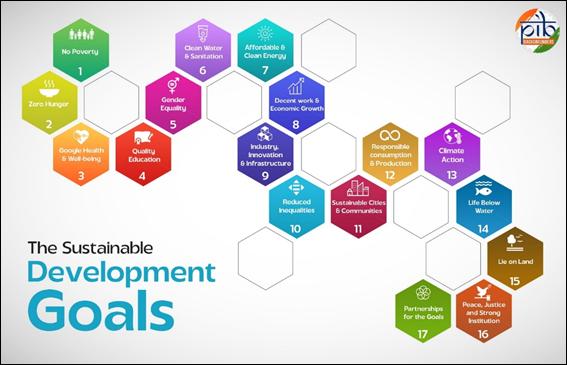
The SDGs are not only about growth. They look at how the world can become fairer, safer, cleaner, and more equal. This includes better healthcare, education, jobs, clean water, and a healthy environment. The vision is clear: no one should be left behind.
In India, NITI Aayog leads the work on SDGs. It links government schemes with the global goals and works closely with ministries to make sure every department plays its part. The United Nations team in India helps by offering support and ensuring that the goals are well connected, inclusive, and backed by proper funding.
Objectives of the NER District SDG Index 2023–24
The objectives of the NER SDG Index 2.0 are to:
- Rank the districts of the eight NER states based on their relative performance across the 15 SDGs. Goal 14 is not applicable and Goal 17 has limited relevance at the district level.
- Identify critical gaps and challenges in performance and achievements to plan necessary corrective measures.
- Highlight intra-state and inter-state disparities across the eight states to support the design of suitable interventions.
- Promote competitive federalism by enabling state-wise, district-wise, and SDG-wise comparisons. The ranking also acts as a tool for peer learning and performance improvement.
- Create a platform for collaboration and allow districts to share and adopt best practices from one another.
- Identify data gaps in the statistical systems of states and sectors where better and more frequent data collection is needed.
Coverage and Classification in the NER SDG Index 2023–24
The second edition of the NER District SDG Index covers 121 out of 131 districts in the region. This marks a clear step up from the first edition, which had data from 103 out of 120 districts. The expansion reflects better reporting and deeper involvement from the states.
The Index uses 84 indicators to measure progress. Out of these, 41 are based on data from Union Government sources, while the remaining 43 come from state-level systems. There has been a notable improvement in how districts report data to the Centre. This has made the results more credible and more useful for planning development work.
The Index tracks progress across 15 Sustainable Development Goals as shown below:
|
SDG No.
|
Goal
|
|
SDG 1
|
No Poverty
|
|
SDG 2
|
Zero Hunger
|
|
SDG 3
|
Good Health and Well-being
|
|
SDG 4
|
Quality Education
|
|
SDG 5
|
Gender Equality
|
|
SDG 6
|
Clean Water and Sanitation
|
|
SDG 7
|
Affordable and Clean Energy
|
|
SDG 8
|
Decent Work and Economic Growth
|
|
SDG 9
|
Industry, Innovation and Infrastructure
|
|
SDG 10
|
Reduced Inequalities
|
|
SDG 11*
|
Sustainable Cities and Communities
|
|
SDG 12
|
Responsible Consumption and Production
|
|
SDG 13
|
Climate Action
|
|
SDG 15
|
Life on Land
|
|
SDG 16
|
Peace, Justice and Strong Institutions
|
*Note: SDG 11 was scored only for 79 districts with urban bodies and was excluded from overall composite scores.
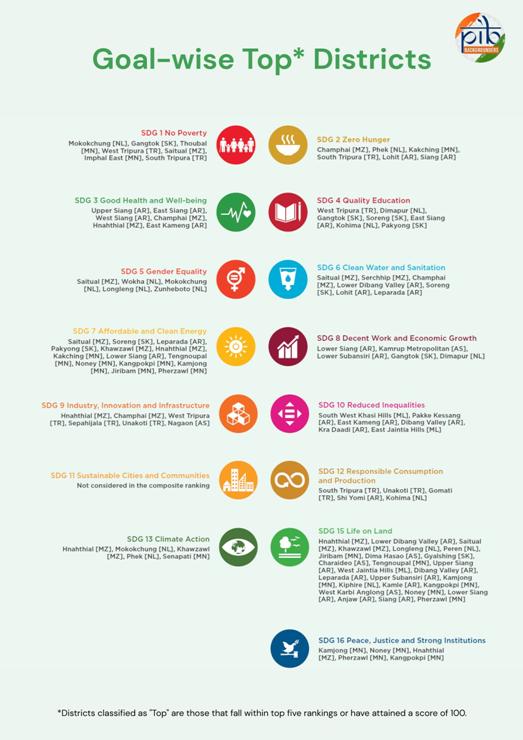
Categorisation of Districts
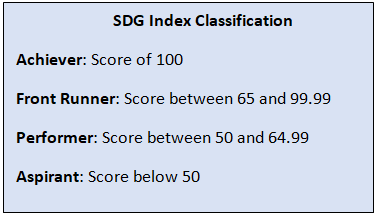 The Sustainable Development Goals cover a wide range of areas, from health and education to economy, environment and governance. Each goal has many targets, and all of them are closely linked. This makes it difficult to create exact categories for measuring how well a district is doing on all fronts.
The Sustainable Development Goals cover a wide range of areas, from health and education to economy, environment and governance. Each goal has many targets, and all of them are closely linked. This makes it difficult to create exact categories for measuring how well a district is doing on all fronts.
To keep things simple and easy to understand, a clear method of classification was used. Districts were grouped into four categories based on how close they are to the targets set under the SDGs.
These categories are as follows:
- Achiever: Districts that have met the target
- Front Runner: Districts that are close to meeting the target
- Performer: Districts that show moderate progress
- Aspirant: Districts that need more focused attention
This approach helps track progress in a straightforward way and points to where efforts are most needed.
Comparing SDG Performance Across Editions
The second edition of the NER District SDG Index shows clear progress across many goals when compared to the first edition. More districts have moved into the Front Runner and Achiever categories, reflecting improved efforts on the ground.
Overall, there has been a rise in the proportion of districts in the Front Runner category from 62 percent in 2021-22 to 85 percent in 2023-24. This improvement reflects the combined impact of national flagship schemes, focused localisation efforts by states, and the push for saturation of services through initiatives like the Aspirational Districts Programme.
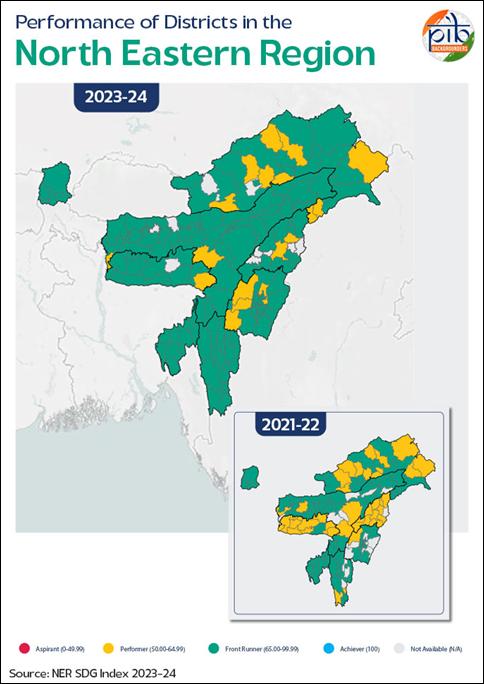
The progress across different SDGs are given below:
Districts in the Front Runner category have increased from 21 to 36. Aspirant districts have reduced sharply from 20 to just 3. This suggests stronger outreach and support systems for poverty reduction.
There has been major progress. Front Runner districts rose from 49 to 83, while Aspirant districts dropped from 21 to just 1. Nutritional support schemes appear to be making an impact.
SDG 3: Good Health and Well-being
The number of Front Runner districts jumped from 14 to 48. Aspirant districts declined from 18 to 6, showing better access to health services.
Districts in the Front Runner category have more than doubled, rising from 36 to 80. The number of Aspirant districts is now down to 11.
This goal has seen broad gains, with 112 districts now in the Front Runner category, up from 71. The number of Aspirant districts has fallen to just 1.
SDG 6: Clean Water and Sanitation
Front Runner districts rose from 81 to 114. Programmes like Jal Jeevan Mission and Swachh Bharat Mission have played a key role in this shift.
SDG 7: Affordable and Clean Energy
The number of Achiever districts has doubled from 7 to 14. This goal reflects progress in village electrification and clean cooking fuel use.
SDG 8: Decent Work and Economic Growth
Front Runner districts have increased significantly, from 69 to 111. This indicates better access to economic opportunities and employment.
SDG 9: Industry, Innovation and Infrastructure
The number of Front Runner districts rose from 55 to 92, showing better connectivity and infrastructure planning.
SDG 10: Reduced Inequalities
Front Runner districts are 43 as against 59 in the last index, while Aspirant districts are 33 as against 12. The report calls for focused attention on relevant indicators.
SDG 12: Responsible Consumption and Production
Front Runner districts declined from 67 to 51. Aspirant districts remain at 18, indicating the need to raise awareness on responsible consumption.
Four districts have achieved a perfect score. The number of Front Runners rose from 36 to 59. But 49 districts still remain in the Aspirant category, showing the need for stronger climate strategies.
Achiever districts have increased from 12 to 26. The Front Runner group now includes 87 districts, showing greater attention to forest and biodiversity conservation.
SDG 16: Peace, Justice and Strong Institutions
There is steady improvement, with Front Runner districts rising from 64 to 90. However, Aspirant districts have also increased slightly, from 1 to 5.
State-wise Profiles
The North Eastern Region is marked by rich diversity, both in geography and development patterns. The district-wise analysis across the eight states brings out local strengths, gaps, and variations in progress on the Sustainable Development Goals. While some states like Mizoram, Sikkim, and Tripura have all their districts in the Front Runner category, others display a mix of high and moderate performers, with a few districts still needing focused attention.
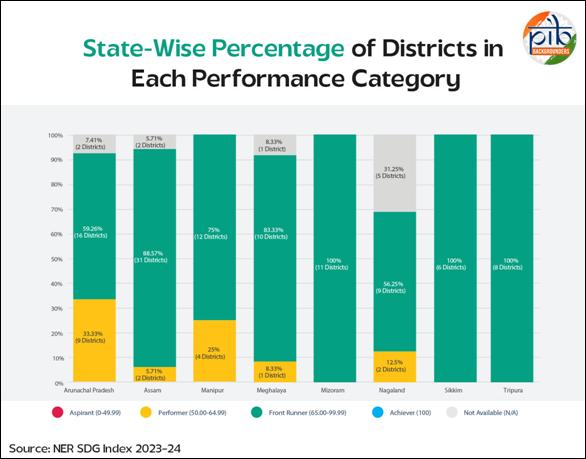
Arunachal Pradesh had 25 districts assessed. Around 59 percent were categorised as Front Runners and 33 percent were Performers. The state showed progress in Clean Water and Sanitation (SDG 6), Gender Equality (SDG 5) and Decent Work and Economic Growth (SDG 8) and Life on Land (SDG 15). Challenges remain in Climate Action (SDG 13) and Industry, Innovation and Infrastructure (SDG 9). Lower Dibang Valley ranked highest, while Longding was the lowest.
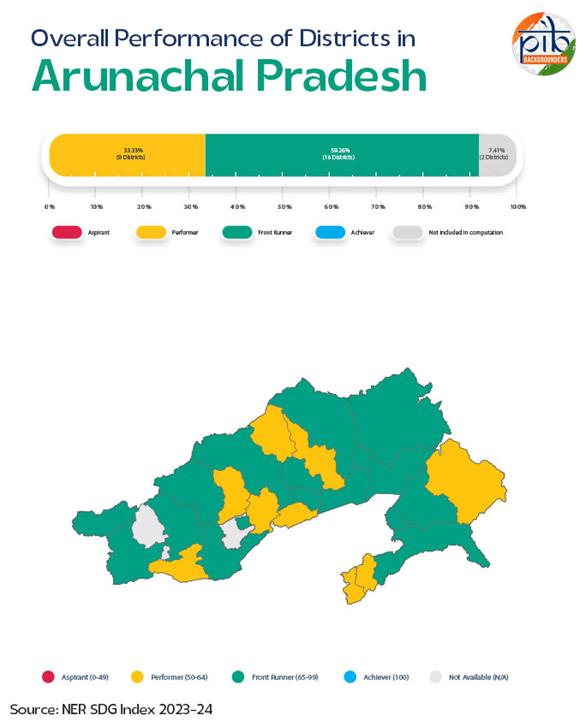
Assam had 33 districts covered in the index. About 89 percent of them were Front Runners, showing steady improvement. The state performed well in Decent Work and Economic Growth (SDG 8), Industry, Innovation and Infrastructure (SDG 9), and Gender Equality (SDG 5). Dibrugarh ranked the highest, while South Salmara-Mankachar was at the bottom.
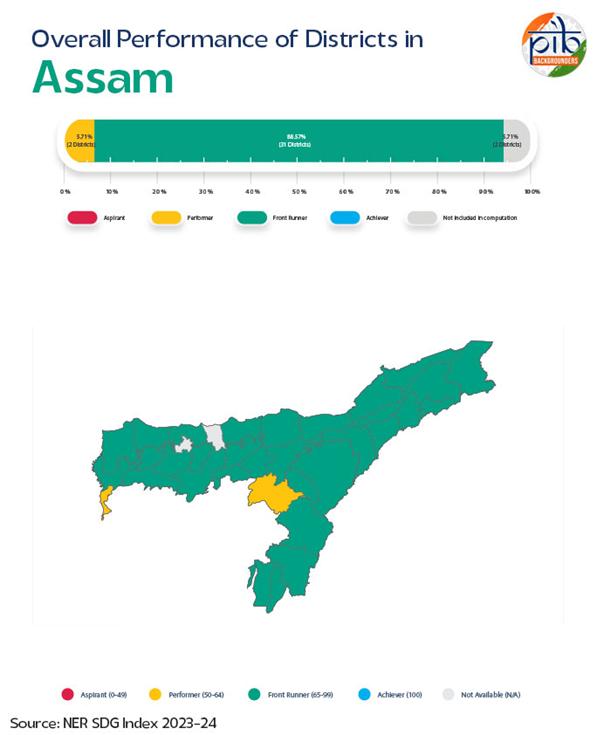
All 16 districts from Manipur were assessed. About 75 percent were Front Runners. The state performed well in Clean Water and Sanitation (SDG 6), Affordable and Clean Energy (SDG 7), Decent Work and Economic Growth (SDG 8), Sustainable Cities and Communities (SDG 11) and Peace, Justice and Strong Institutions (SDG 16). However, it still needs to strengthen efforts in Reducing Inequalities (SDG 10). Imphal West was the top district, and Pherzawl was ranked lowest.
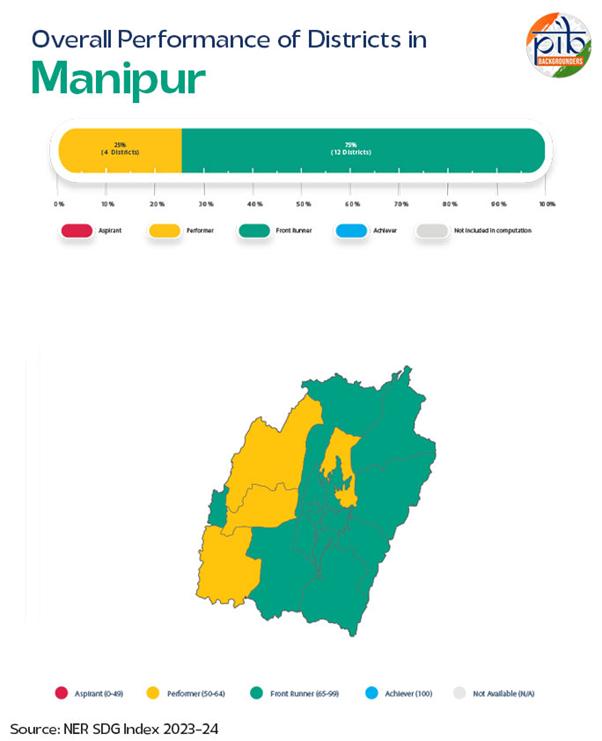
11 districts of Meghalaya were included. 84% were Front Runners. The state has shown progress in Clean Water and Sanitation (SDG 6), Industry, Innovation and Infrastructure (SDG 9), and Life on Land (SDG 15). However, it needs to improve performance in Quality Education (SDG 4). East Khasi Hills ranked the highest, and East Jaintia Hills the lowest.
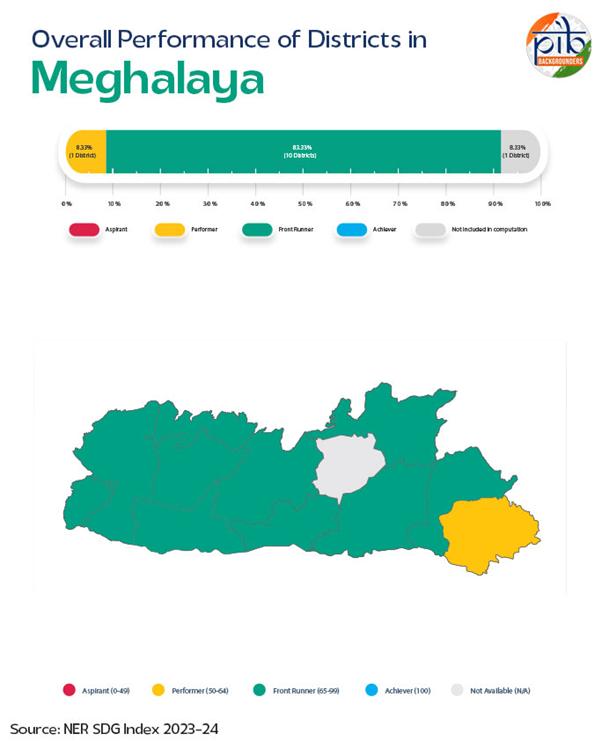
All of Mizoram’s 11 districts were placed in the Front Runner category. Hnahthial secured the top rank across the entire North Eastern region. The state performed well in Gender Equality (SDG 5), Clean Water and Sanitation (SDG 6), Affordable and Clean Energy (SDG 7), Decent Work and Economic Growth (SDG 8), Industry, Innovation and Infrastructure (SDG 9), Life on Land (SDG 15) and Peace, Justice and Strong Institutions (SDG 16).
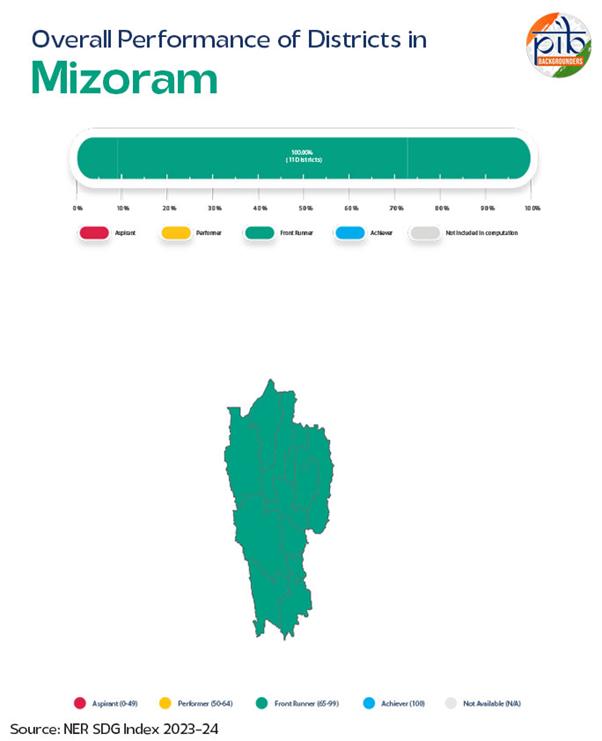
Nagaland had 11 districts assessed in the Index. 9 districts were categorised as Front Runners. Mokokchung ranked among the top districts in the region, while Zunheboto was among the lower-scoring ones. The state performed well in Gender Equality (SDG 5), Clean Water and Sanitation (SDG 6), Decent Work and Economic Growth (SDG 8), Sustainable Cities and Communities (SDG 11), Zero Hunger (SDG 2), Climate Action (SDG 13), and Life on Land (SDG 15). However, it needs to improve on Reducing Inequalities (SDG 10).
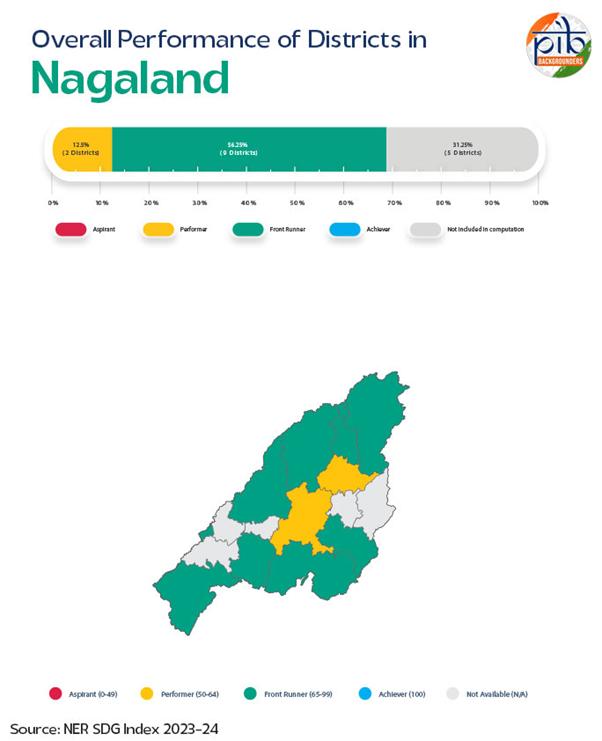
All 6 districts in Sikkim were ranked as Front Runners. The state had the narrowest score gap, showing balanced development. Gangtok was the top-performing district. Sikkim performed well in Zero Hunger (SDG 2), Quality Education (SDG 4), Gender Equality (SDG 5), Clean Water and Sanitation (SDG 6), Affordable and Clean Energy (SDG 7), Decent Work and Economic Growth (SDG 8), Sustainable Cities and Communities (SDG 11), Life on Land (SDG 15) and Responsible Consumption and Production (SDG 12).
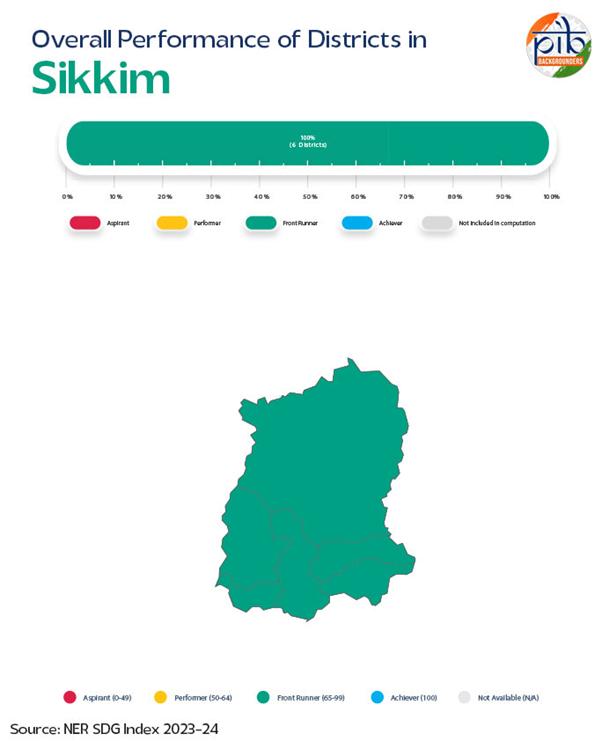
All 8 districts of Tripura were covered in the Index, with each one placed in the Front Runner category. The state performed notably well across several goals, including Quality Education (SDG 4), Gender Equality (SDG 5), Decent Work and Economic Growth (SDG 8), and Industry, Innovation and Infrastructure (SDG 9). It also showed strength in Reduced Inequalities (SDG 10), Sustainable Cities and Communities (SDG 11), Responsible Consumption and Production (SDG 12), Life on Land (SDG 15), and Peace, Justice and Strong Institutions (SDG 16). Gomati emerged as the top district, while Dhalai registered the lowest score in the state.
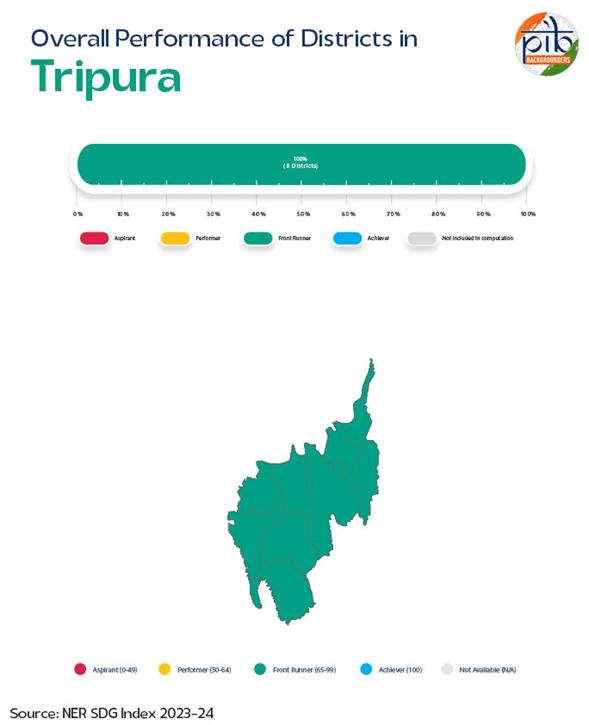
Top Performing Districts
Among the top 10 districts in the NER District SDG Index 2023–24, Mizoram had three — Hnahthial, Champhai and Kolasib. Tripura also had three districts on the list — Gomati, West Tripura and South Tripura. Nagaland featured with Mokokchung, Kohima and Dimapur. Sikkim had one district, Gangtok, in the top ten. This spread reflects the strong and consistent performance of these states in advancing sustainable development goals.
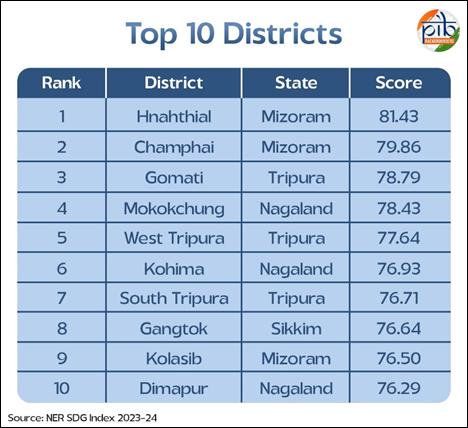
Key Thematic Insights
- Hnahthial in Mizoram has the highest score in all of Northeast India (81.43), while Longding in Arunachal Pradesh has the lowest score (58.71).
- Nagaland shows the biggest difference between its best and worst performing districts (a gap of 15.07 points).
- Sikkim has the smallest difference (only 5.5 points), so all its districts perform almost equally well.
- Tripura has some of the top-performing districts and also shows very little difference between them (only 6.5 points).
- Mizoram and Nagaland both have high-scoring districts, but also big differences between their best and worst performing areas (13.72 and 15.07 points).
- Programmes such as Jal Jeevan Mission and Swachh Bharat Mission have played a major role in improving access to water and sanitation.
- Localised planning, regular monitoring, and better data systems have helped districts perform more consistently across multiple goals.
- While districts have done well in goals like Health, Education, Water, and Gender Equality, challenges remain in areas such as Climate Action, Inequality, and Responsible Consumption.
- Better reporting from states has made the Index more reliable. Still, some gaps remain, especially in newly created or remote districts.
Conclusion
The NER District SDG Index 2023–24 offers valuable insights into the development journey of India’s North Eastern Region. It captures the gains made through targeted schemes, improved governance, and local-level planning, while also highlighting areas that need greater attention. The rise in the number of Front Runner districts and the narrowing gaps in several states reflect growing commitment and capacity across the region.
At the same time, disparities within and between states, especially in climate resilience, inequality, and sustainable practices, call for focused and sustained efforts. As states and districts continue to build on this momentum, the Index serves not only as a mirror of progress but also as a guide for planning inclusive and sustainable development in the years to come.
References:
UNDP:
NITI Aayog:
Downlod in PDF
***
RT/SM
(Backgrounder ID: 154877)
Visitor Counter : 412
Provide suggestions / comments